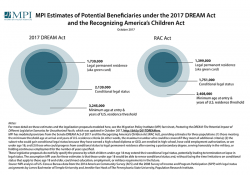Protecting the DREAM: The Potential Impact of Different Legislative Scenarios for Unauthorized Youth
Congressional efforts to legalize unauthorized immigrants who were brought to the United States as children have been pending in Congress since 2001, with the DREAM Act garnering notable bipartisan support over the years. With the Trump administration having decided to rescind the Deferred Action for Childhood Arrivals (DACA) program, which has provided temporary relief from deportation to nearly 800,000 DREAMers, there may be new momentum—and pressure—on Congress to act to grant legal status to a population viewed sympathetically by many on both sides of the political aisle.
MPI researchers estimate 2.1 million people under the 2017 DREAM Act introduced by Sens. Lindsey Graham (R-SC) and Richard Durbin (D-IL); and 1.7 million under the Recognizing America's Children Act (RAC Act) introduced by Rep. Carlos Curbelo (R-FL) would be eligible to earn conditional legal status by meeting high school educational or equivalent requirements. Of these, a smaller subset—1.7 million under the Senate bill and 1.4 million under the RAC Act—would be likely to satisfy the college completion, military enlistment, or other professional criteria to get legal permanent residence (also known as getting a green card).
The fact sheet, which updates estimates issued in July 2017, uses an innovative MPI methodology to assign legal status within Census Bureau data and to study attributes of the unauthorized.




